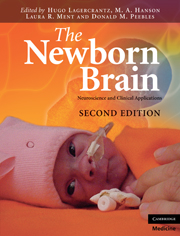Book contents
- Frontmatter
- Contents
- List of contributors
- Preface to the First Edition
- Preface to the Second Edition
- 1 Reflections on the origins of the human brain
- Section 1 Making of the brain
- Section 2 Sensory systems and behavior
- Section 3 Radiological and neurophysiological investigations
- Section 4 Clinical aspects
- Section 5 Follow-up
- 20 Injury and recovery in the developing brain
- 21 Development of motor functions in health and disease
- 22 Antenatal glucocorticoids and programming of neuroendocrine function and behavior
- Section 6 Consciousness
- Index
- Plate section
- References
20 - Injury and recovery in the developing brain
from Section 5 - Follow-up
Published online by Cambridge University Press: 01 March 2011
- Frontmatter
- Contents
- List of contributors
- Preface to the First Edition
- Preface to the Second Edition
- 1 Reflections on the origins of the human brain
- Section 1 Making of the brain
- Section 2 Sensory systems and behavior
- Section 3 Radiological and neurophysiological investigations
- Section 4 Clinical aspects
- Section 5 Follow-up
- 20 Injury and recovery in the developing brain
- 21 Development of motor functions in health and disease
- 22 Antenatal glucocorticoids and programming of neuroendocrine function and behavior
- Section 6 Consciousness
- Index
- Plate section
- References
Summary
Introduction
Preterm delivery, especially when associated with very low birthweight (VLBW, <1500 g) or extremely low birthweight (ELBW, <1000 g), represents a major insult to the developing brain. VLBW premature infants make up 1%–2% of all live-births, and more than 85% survive the neonatal period (Mc'Intyre et al., 1999). Unfortunately, the increase in survival among premature infants in the 1990s was accompanied by a reported increase in disability (Wilson-Costello et al., 1998). In addition, the brains of preterm children have been shown to be 6% smaller than term controls at school age, and numerous structural and microstructural differences in brain development have been documented in the preterm population (Reiss et al., 2004).
In contrast, recent reports document improvement in testing scores and academic performance across time for the prematurely born, and imaging studies suggest the development of alternative strategies for language processing in preterm subjects at adolescence. Furthermore, numerous preclinical studies have documented the developing brain's ability to engage in regenerative and recovery mechanisms (Vaccarino & Ment, 2004). Taken together, these findings suggest that preterm birth alters the genetically determined pattern of corticogenesis, and that compensatory mechanisms may promote neural and functional plasticity in the developing brain.
Injury to the developing brain
The most common forms of injury to the developing preterm brain are intraventricular hemorrhage (IVH), cystic periventricular leukomalacia (cPVL), and white matter injury. Other, relatively less common, findings predictive of developmental sequelae include cerebellar hemorrhages and basal ganglia/thalamic lesions (Limperopoulos et al., 2005a,b; Dyet et al., 2006).
- Type
- Chapter
- Information
- The Newborn BrainNeuroscience and Clinical Applications, pp. 329 - 344Publisher: Cambridge University PressPrint publication year: 2010



